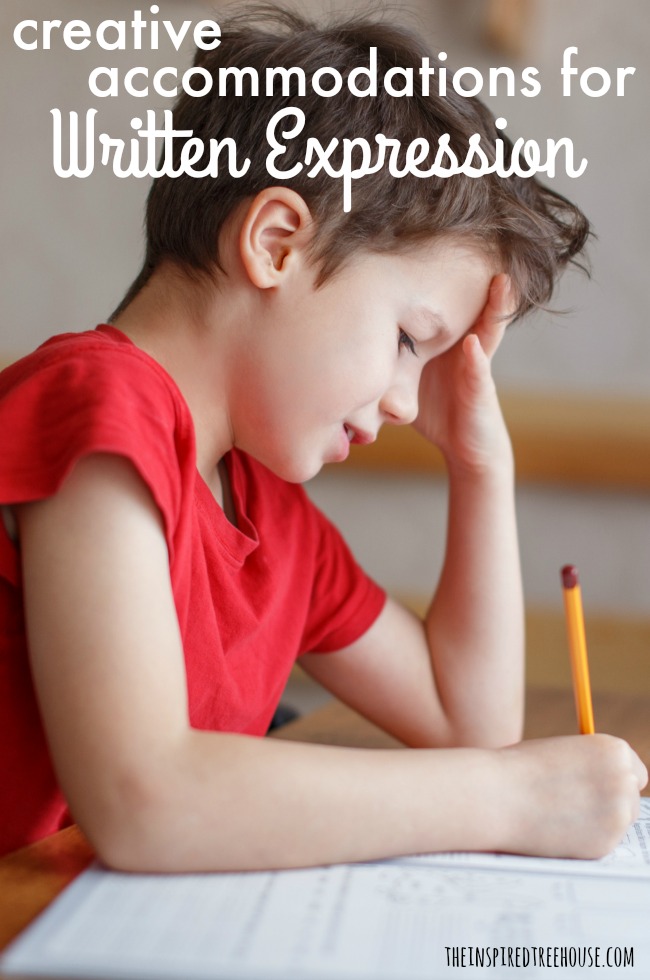These creative accommodations are great ways to support kids who struggle with written expression.
If you’re a parent, teacher, or therapist, chances are that you know at least a kid or two who struggles with written expression.
For these kids, looking at a blank worksheet, journal page, or test paper can be totally overwhelming. They might they might attempt handwriting assignments like these, only to realize that they can’t keep up with their peers. Or maybe they can complete the assignment but they fall short when it comes to spacing, sizing, alignment, or letter formation.
Finally, these kids usually get frustrated and overwhelmed – shutting down and giving up before they even try.
Why Kids Struggle With Written Expression
It’s often very complicated to pick apart why a child is struggling with written expression. Sometimes they’re struggling with one of the following areas, but more often there are a number of these factors that are getting in the way of a child being able to show what he knows through writing.
1 || Visual perception deficits
2 || Spelling and reading concerns
3 || Oculomotor and other visual concerns
4 || Decreased hand strength
5 || Visual motor integration deficits
6 || Sensory concerns
7 || Attention problems
8 || Motor planning issues
9 || Processing problems
10 || Executive functioning deficits (generating ideas, planning, organizing writing)
And these are only some of areas that can impact a child’s ability to perform on written expression tasks. It’s easy to see why so many kids struggle in this area when there are so many complicated factors at play.
Accommodations for Written Expression
While there are many ideas and interventions that can help kids improve their handwriting, when it comes to day-to-day assignments and classroom activities, what kids really need are ways to help them keep up, understand the material, and stay on track with the pace of the classroom.
In a lot of cases, assistive technology for kids who struggle with handwriting can be a lifesaver. And often, some lower tech options can also be used to help kids who are struggling writers be more successful on tests, note-taking, and other assignments in the classroom.
These ideas can help kids with note-taking, journal writing, math assignments, and test-taking. Click here for the free printable!
1 || Fill-in-the-blank format
Provide journal pages that have prompt sentences pre-printed on the page with words for the child to fill in.
For note-taking, provide pre-printed notes with blanks for kids to fill in key words.
2 || Highlighted lines
Highlighted writing lines can provide a visual prompt to encourage better alignment and sizing.
3 || Boxes and lines
Open writing spaces can be very difficult for struggling writers. Add boxes or writing lines to open spaces to give a visual structure to the task.
4 || Visual and tactile guides
Cut a window out of a plastic folder that is the appropriate size for shorter written responses on worksheets or tests (e.g. spelling tests). Have kids place the window on top of the blanks on the paper, writing inside the cutout. This can help with sizing and alignment.
Wikki stix can also be used to create raised boxes and lines on paper.
5 || Adaptive paper
Use paper with raised lines, highlighted lines
, shaded lines, or boxes to provide a visual cue for spacing, sizing, and alignment. This can require some problem-solving to figure out which type of paper works for each child.
6 || Graph paper
Use graph paper or paper with larger boxes to help kids organize and line up math problems. Kids can also use graph paper to help provide a structure for writing letters, words, and sentences.
7 || Voice recorder
For older kids, using a voice memo recorder on a tablet or smartphone can be a good strategy to replace taking notes or as a supplement to note-taking.
8 || Close model
Providing a nearpoint model of the information being presented can be a good strategy for kids who need to copy rather than writing on their own. This can be a full version of the information or an abbreviated version.
9 || Dictating
Many kids will need to dictate their responses to be written by someone else. They may then be able to copy the responses onto their paper.
10 || Self-editing
Providing a written self-editing list can be helpful for some kids to be able to go back and check their sizing, spacing, alignment, overall legibility, and punctuation.
11 || Word bank
Providing a word or phrase bank can help kids narrow down the correct response to a question on their paper and gives them a model to copy from.
12 || Adjust time and volume of writing
Many kids benefit from increased time to complete written expression activities and/or decreased expectations for how much they need to write.
13 || Highlighting notes
Rather than taking notes, provide kids with a pre-printed version of the notes and a highlighter so they can highlight the information as it’s being presented.
14 || Cooperative writing
Kids can team up on writing assignments so each does the work for a different part of the assignment (outlining/brainstorming, writing, proofreading/editing).
15 || Make it hands-on
So many kids struggle with pencil/paper tasks and can benefit from assignments that are adapted for a more hands-on approach. Instead of a word bank, try placing small stickers or pieces of masking tape with the words written on them on the child’s desk. He can then peel them off to place them in the correct spaces on the page.


Latest posts by Claire Heffron (see all)
- Cute Zipper Bags for Therapists - April 18, 2024
- Fairy Tale Games and Toys - April 12, 2024
- The Best Emotional Regulation Books for Kids - April 8, 2024

